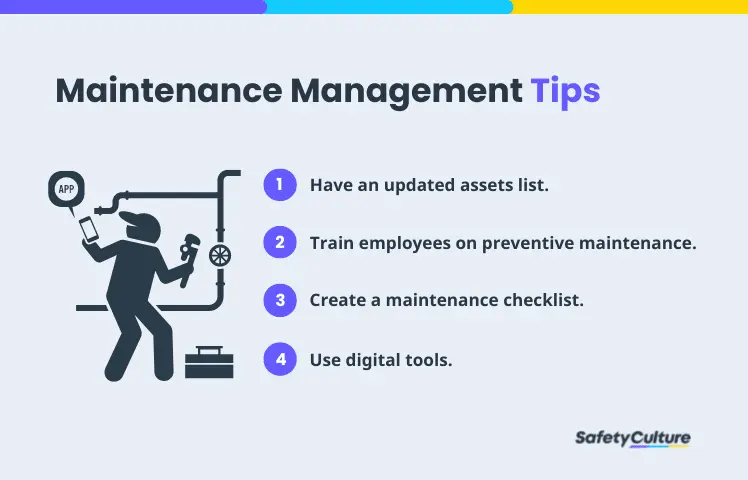What is Maintenance Management?
Maintenance management is the process of keeping track of company assets and overseeing maintenance activities. Organizing maintenance activities will ensure that every asset’s performance is optimized. Maintenance doesn’t only revolve around repairing assets such as equipment and machinery but also includes other procedures such as inspection and cleaning to keep these assets in working condition.
Why is Maintenance Management Important?
Equipment maintenance requires a lot of time and effort. For organizations that operate with multiple equipment and machinery, maintenance management is an important process to incorporate since this methodological approach will keep processes in order.
To put things into perspective, maintenance should be done periodically and by following a schedule. With this knowledge, a manager can implement a regular schedule for maintenance activities. Maintenance schedule allows employees to better manage their other work tasks and include maintenance activities without it affecting the rest of their responsibilities for the day. This can be done manually or by using a digital tool that can automate maintenance schedules and employee assignments. This management approach solves time constraints which can hinder personnel from consistently carrying out equipment maintenance.
Another reason to incorporate a maintenance management approach is that it helps prevent avoidable risks such as equipment failure and work incidents from happening.
As it is highly recommended to utilize a strategy that fits your organization’s requirements here are some vital maintenance management strategy tips:
- Have an updated assets list – audit all your equipment and machinery. This list is the first step on creating a maintenance plan and will be the source of information on what the organization currently owns. An assets list can help a manager create a maintenance plan and schedule how often a specific asset needs to be inspected, cleaned, serviced, and lubricated, among other maintenance activities.
- Train employees on preventive maintenance – managers should properly train personnel on the effective maintenance of each asset such as conducting periodic maintenance. This proactive approach is commonly done by scheduling maintenance ahead of the task. Empower technicians to remain on schedule and perform maintenance activities.
- Create a maintenance checklist – certain maintenance tasks are sometimes forgotten and a way to prevent this from happening is to use checklists that contain all maintenance tasks. This ensures that the maintenance will be thorough and complete. The checklist should be specific for the equipment model and maintenance purposes. Managers can also create a sequential checklist for an efficient maintenance procedure.
- Use digital tools – efficiency is key for effective maintenance management. Certain digital tools have features that help keep track of maintenance activities, create checklists, and automate processes such as scheduling and assigning tasks to certain personnel.

Maintenance Management Tips | SafetyCulture
Benefits of Maintenance Management
It’s now clear why maintenance management is vital for any organization. Businesses that regularly maintain their assets can prevent asset failure or downtime which leads to production loss and project reschedules.
The following are the benefits of incorporating maintenance management:
- Technician and equipment safety – maintenance helps businesses stay compliant with safety regulations and industry standards. This practice keeps your employees safe since issues that can cause preventable accidents can be caught and reported during an inspection. Managers should apply corrective action to machine issues that pose safety hazards as soon as possible. Another reason why maintaining the equipment benefits an organization is that it improves productivity by keeping machines performing according to the industry standard. Standards are set in place to not only ensure that equipment runs smoothly but also safely.
- Extend assets’ useful life – Maintenance is proven effective to extend asset usability and prevent sudden failure. Most machine problems are preventable by regular cleaning and lubricating. Replacing broken components is another cheaper option to extend asset life than buying new equipment. Another tip is to keep replacement parts of important equipment to lessen production loss.
- Equipment efficiency – It’s normal for certain equipment to eventually run inefficiently due to wear and tear. Regular maintenance helps keep assets in good condition and reduce discrepancies in output during production due to varying equipment performance. Additionally, this process keeps the equipment running when it should be and prevents wasting company time due to unscheduled asset downtime.
How to Create an Effective Maintenance Management Plan
Here are the steps on how to start managing maintenance:
-
Go over the asset list
Keep the list updated. This will ensure that no equipment is neglected.
-
Create a maintenance requirement for the assets
Each equipment and machine will require different maintenance tasks. Additionally, these assets have to comply with its specific standards. Prevent compliance mistakes by consulting with experts and reading the user manual. Check warranty requirements as well. Common ways to keep warranties valid is to only use the equipment in its intended purpose and know if modifications are allowed.
-
Start organizing equipment maintenance
Categorize by type of equipment and schedule of maintenance.
-
Create the maintenance schedule
This can be specific to a date or frequency. A tip is to automate the maintenance schedule by using a system or tool.
-
Assign an employee or team of technicians
Train these employees by their assigned machine to help them master the maintenance procedure for that equipment. There are tools available that can assign specific maintenance tasks to an employee.
-
Employ maintenance checklists
Customize these checklists according to the organization’s requirements. As stated earlier, this reduces employee mistakes and allows for a thorough review and maintenance of the machine.
Create Your Own Maintenance Checklist
Eliminate manual tasks and streamline your operations.
Get started for FREE-
Analyze reports and apply corrective action
Managers should check for recurring equipment problems. These issues may have been costing the company more than they should, and it’s up to managers to keep or replace the equipment.
And that’s it, managers should always update the assets list and adjust the maintenance management plan.



